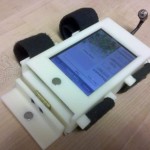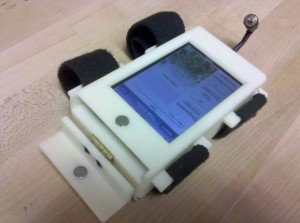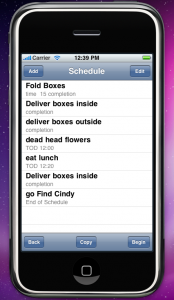Designers: Jakub Dmochowski, Michael Millard, Sergio Olivas, Bradley Brown
Client Coordinator: Gena Brown
INTRODUCTION
Our client, a 20-year-old male with autism, works at a plant nursery. This was arranged through Goodwill Industries’ placement services and a Goodwill job coach supervises the client there on a daily basis. Our client is assigned a set of specific tasks at work each day, ranging from folding boxes to working on garden chores. While he can independently perform each of his tasks, he has difficulty transitioning between tasks because he becomes engrossed in his current activity. As a result, his job coach has to help him transition throughout the day.
Our goal was to develop a device that improves his ability to transition between tasks, furthering his independence in the workplace. He could also use the device at home to transition between household chores. There were several important criteria. Because the nursery spans over half an acre, the device had to be portable without impeding his ability to work. An audible prompt to transition would not be effective because the nursery is located next to active train tracks. Finally, due to the fact that the nursery is mostly outdoors, the device must be safe and durable in that environment.
We developed a device based on an iPod Touch (Apple Computer, Cupertino CA). The iPod Touch is a handheld computer that has a large touch screen for user interaction. In order to fasten the device to the client, we enclosed the iPod Touch in a custom case that straps to the user’s forearm. The case also includes a vibration motors that prompt the user to transition.
SUMMARY OF IMPACT
“The client does a variety of jobs at a plant nursery. This tool will be instrumental in structuring his day and affording him the ability to transition from task to task with little or no intervention from another staff member. This is huge in a place where people are very busy and the client needs to be able to work independently.” -Gena Brown, Goodwill Job Coach.
TECHNICAL DESCRIPTION
The iPhone Software Developer Kit was used to develop the application. The software application was divided into two modes: the task scheduling mode for the supervisor and the operational mode for the client. The task scheduling mode allows a supervisor to generate a schedule for the day. In the Task Editor, the supervisor can create or edit a particular task. Parameters include a name, instructions, and a picture. The supervisor can also choose from the following alarm settings: work for a specified length of time, work until a certain time of day, or work until completion (i.e. until entire stack of boxes are folded). In the Schedule Editor, the supervisor can look at the list of tasks stored in memory and use their finger to slide them into their desired order for the day.
The supervisor or client touches the BEGIN button to transition to the Operational Mode, which executes the schedule for the client. Because this is the client’s user interface, it has a simple layout with a single large button, an image of the current task, and instructions entered by a supervisor. For the alarm settings that are time-dependent, there is a progress bar. When time expires, the client is alerted by vibrations from the case. This instructs him to touch the button, making a check mark appear and turning off the vibration. A new screen displaying a picture of the next task will then appear. The client must then touch the BEGIN button to indicate he has started the next task. This process will continue until all tasks set for the day are completed.
To complement the iPod Touch application, a custom vibrating case was constructed to provide tactile cues when it is time for the client to transition. The application triggers the vibration motors by playing a “song” stored on the iPod Touch, which consists of a low frequency tone. The audio output jack connects to custom circuitry, which uses a comparator to amplify the audio signal and drive the vibration motors. A rechargeable lithium-polymer battery, with a capacity of 1000 mAh, powers the electronics. With the use of a low-power comparator, the fully charged battery will operate for approximately two weeks, assuming daily use of four hours. We developed a built-in recharging circuit based on the MAX1555 integrated circuit.
The structure of the case was designed with two compartments. The front compartment houses the iPod Touch. The case has a large window that provides full access to the iPod Touch screen, while covering the “home” button to prevent the client from using that button to exit the program. The rear compartment houses the electronics and vibration motors. Finally, adjustable Velcro straps were used to secure the case onto the client’s forearm.
The case was modeled using computer aided design software and made from ABS thermoplastic on a fused deposition modeling (FDM) system. ABS is a lightweight, durable material that can withstand environmental conditions. To ensure the client’s safety, edges of the case were rounded.
The total cost of this device was $250, including the cost of a $107 software license from Apple, but not including the cost of a donated iPod Touch.





University Operator: (919) 962-2211 | © 2024 The University of North Carolina at Chapel Hill |